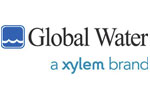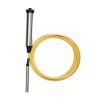Global Water FL16 Flow Logger
Features
- Compact, self-powered and easy to use
- User programmable start and stop alarms, engineering units, and field calibration setup
- Automatic barometric pressure and temperature compensation
- Free ground shipping
- Expedited repair and warranty service
- Lifetime technical support
- More
Overview
The Global Water FL16 Water Flow Loggers will record over 81,000 depth, temperature, water flow and velocity readings in sewer and drainage pipes, as well as other open channel applications like flumes, weirs and square channels. The specially engineered, non-fouling water level sensor works in depths as little as 0.5 inch and allows for deployment in manholes and other difficult to access areas without the need to enter the confined space.
Design
The FL16 Water Flow Recorder's vented water flow sensor is fully encapsulated with marine-grade epoxy. The water flow sensor's electronics are encapsulated so that moisture can never leak in through O-ring seals or work its way into the vent tube and cause drift or sensor failure, as is the case with many other vented water flow sensors. The vent tube is sealed directly to the wet-wet sensing element, and any moisture that may enter the vent tube from the Water Flow Recorder's housing will only contact the ceramic parts, not the electronics.
In The News
Stone Lab: Cyanobacteria Monitoring in Ohio Lakes
Microcystin, one of several toxins produced by the cyanobacteria that form harmful algal blooms (HABs), has become a popular topic of lake research as the human health impacts of HABs become better understood. Stone Lab is one of the leading groups in algal bloom research on Lake Erie and other lakes in Ohio. For more than 100 years, Stone Lab has conducted biology research and provided science education and outreach to the region. Over the years, thousands of individuals of varying ages have learned from the resources Stone Lab provides. Stone Lab’s Research Coordinator and Senior Researcher, Justin Chaffin, learned of Stone Lab while an undergraduate student at Bowling Green State University Fireland Campus.
Read MoreFrom Assessment to Angler: Continual Research Ensures Lake Erie Remains a Beacon of Freshwater Fishing
Lake Erie is well known for its abundant recreational fishing. Anglers come from across the country to try their luck at the “walleye capital of the world” and search for other freshwater species, such as bass, perch, and steelhead trout. As one of the world’s largest freshwater fisheries, much effort is made behind the scenes to maintain fishing opportunities for visitors to enjoy year after year, efforts that often go unnoticed by the public. One of the lake's most important economic and tourism centers is the city of Sandusky, home to the Sandusky Fisheries Research Station . As part of the Ohio Division of Wildlife, the unit serves as a base for assessing fish populations and managing harvest with partner agencies from around Lake Erie.
Read MoreHigh Definition Stream Surveys: Informed Management in Local Waterways
When it comes to environmental monitoring, new stream survey methodologies have revealed a great deal about water quality and streambed conditions over time. Such information can be particularly important in leading restoration initiatives and prioritizing management decisions. Historically, stream surveys have been conducted at a single point along the stream, with data then extrapolated for miles up and downstream. However, Brett Connell, Hydrologist and Director of Sales at Trutta Environmental Solutions, started developing a more intensive stream survey format in his master's program in 2010 at the University of Tennessee.
Read More








